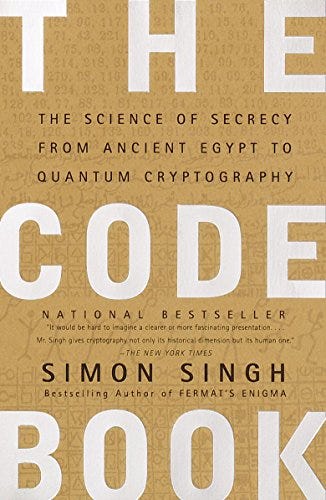The Code Book Summary

The Code Book, written by Simon Singh, is a fascinating journey through the history of codes and cryptography. The book covers the development of various ciphers, from ancient times to modern-day encryption methods.
The author starts by introducing readers to the basics of cryptography and how it has been used throughout history, including examples from ancient Greece, Rome, and Egypt. The book then moves on to the development of more complex ciphers during the Renaissance, including the famous work of Leonardo da Vinci.
The book also covers the use of cryptography during times of war, including the Enigma machine used by the Germans during World War II. Singh provides a detailed explanation of how the Allies were able to break the code, which was critical in their victory.
The Code Book also discusses the development of modern encryption methods, including public key cryptography and its implications for modern communication. Singh provides an overview of the challenges facing modern cryptography, including quantum computing and the tension between security and privacy.
The book concludes with a look at the future of cryptography and its potential impact on society. Moreover, it is an engaging and informative exploration of the history of codes and cryptography. It is a must-read for anyone interested in the intersection of history, mathematics, and technology.
Overall, Cipher design is a complex process involving mathematics, computer science, and cryptography. There are several methods used to design ciphers, and some of the most common ones are:
- Substitution-Permutation Networks (SPN): SPN is a type of block cipher design that uses substitution and permutation operations on fixed-length data blocks. The substitution operation replaces each byte of the block with a different byte, while the permutation operation rearranges the order of the bytes. The SPN design is used in several famous ciphers, such as AES.
- Feistel Networks: A Feistel Network is another type of block cipher design that divides the input block into two halves and applies a series of round functions to each half. The round functions use a secret key to transform the data, and the output of each round is fed into the next round. The final output of the Feistel Network is the ciphertext. DES is an example of a cipher that uses a Feistel Network.
- Stream Ciphers: Stream ciphers are a type of cipher design that generates a pseudorandom stream of bits, which is then combined with the plaintext to generate the ciphertext. The pseudorandom stream is generated using a secret key and a deterministic algorithm. Stream ciphers are typically faster than block ciphers and are used in applications such as wireless communication and secure messaging.
- Hash-Based Ciphers: A hash-based cipher uses a hash function to generate a one-time key, which is then used to encrypt the plaintext. The hash function is a one-way function that takes an input and generates a fixed-length output. Hash-based ciphers are used in applications where the encryption and decryption keys need to be generated on the fly, such as in secure messaging protocols.
- Lattice-Based Ciphers: A lattice-based cipher uses mathematical structures called lattices to generate a key to encrypt the plaintext. The key is generated using a lattice reduction algorithm, which is a computationally intensive process that makes it difficult to break the cipher. Lattice-based ciphers are used in applications where the cipher's security is critical, such as in military and government communication systems.
The Code Book covers various cipher methods used throughout history. For Instance:
- Caesar Cipher: This cipher is named after Julius Caesar, who used it to encrypt his messages. It involves shifting each letter of the plaintext by a fixed number of positions in the alphabet.
- Vigenère Cipher: This polyalphabetic cipher uses multiple Caesar ciphers with different shift values. It is more secure than the Caesar cipher but can still be easily broken.
- Playfair Cipher: This cipher uses a 5x5 matrix of letters to encrypt the plaintext. The matrix is filled with the letters of a keyword, and the remaining letters are filled alphabetically.
- Enigma Cipher: The Enigma machine was used by the Germans during World War II to encrypt their messages. It used a combination of substitution and permutation operations to generate the ciphertext.
- RSA Cipher: This is a public-key encryption method developed in the 1970s. It uses two keys, one public and one private, to encrypt and decrypt messages.
- Data Encryption Standard (DES): This is a symmetric-key encryption method developed by the U.S. government in the 1970s. It uses a 56-bit key to encrypt and decrypt messages.
- Advanced Encryption Standard (AES): This symmetric-key encryption method was developed in the late 1990s. It uses a 128-bit, 192-bit, or 256-bit key to encrypt and decrypt messages.
To exemplify how cipher works. The Python code below implements three types of cipher that encrypt the message “HELLO WORLD”.
import string
def caesar_cipher(plaintext, shift):
alphabet = string.ascii_uppercase
ciphertext = ""
for char in plaintext:
if char in alphabet:
index = (alphabet.index(char) + shift) % 26
ciphertext += alphabet[index]
else:
ciphertext += char
return ciphertext
def vigenere_cipher(plaintext, key):
alphabet = string.ascii_uppercase
key = key.upper()
key_len = len(key)
key_pos = 0
ciphertext = ""
for char in plaintext:
if char in alphabet:
shift = alphabet.index(key[key_pos]) % 26
index = (alphabet.index(char) + shift) % 26
ciphertext += alphabet[index]
key_pos = (key_pos + 1) % key_len
else:
ciphertext += char
return ciphertext
def playfair_cipher(plaintext, key):
alphabet = string.ascii_uppercase.replace("J", "")
key = key.upper().replace("J", "I")
key_len = len(key)
key_pos = 0
grid = ""
for char in key + alphabet:
if char not in grid:
grid += char
grid_len = len(grid)
if grid_len < 25:
for char in alphabet:
if char not in grid:
grid += char
ciphertext = ""
plaintext = plaintext.upper().replace("J", "I")
plaintext_len = len(plaintext)
plaintext_pos = 0
while plaintext_pos < plaintext_len:
char1 = plaintext[plaintext_pos]
if char1 not in alphabet:
plaintext_pos += 1
continue
char2 = plaintext[plaintext_pos + 1] if plaintext_pos + 1 < plaintext_len else "X"
if char2 not in alphabet:
plaintext_pos += 2
continue
if char1 == char2:
char2 = "X"
plaintext_pos -= 1
row1, col1 = divmod(grid.index(char1), 5)
row2, col2 = divmod(grid.index(char2), 5)
if row1 == row2:
ciphertext += grid[row1 * 5 + (col1 + 1) % 5]
ciphertext += grid[row2 * 5 + (col2 + 1) % 5]
elif col1 == col2:
ciphertext += grid[((row1 + 1) % 5) * 5 + col1]
ciphertext += grid[((row2 + 1) % 5) * 5 + col2]
else:
ciphertext += grid[row1 * 5 + col2]
ciphertext += grid[row2 * 5 + col1]
plaintext_pos += 2
return ciphertext
# Example usage:
plaintext = "HELLO WORLD"
shift = 3
key = "CRYPTO"
playfair_key = "KEYWORD"
caesar_ciphertext = caesar_cipher(plaintext, shift)
vigenere_ciphertext = vigenere_cipher(plaintext, key)
playfair_ciphertext = playfair_cipher(plaintext, playfair_key)
print("Caesar ciphertext:", caesar_ciphertext)
print("vigenere ciphertext:", vigenere_ciphertext)
print("playfair ciphertext:", playfair_ciphertext)Output:
Caesar ciphertext: KHOOR ZRUOG
vigenere ciphertext: JVJAH KQIJS
playfair ciphertext: GYIZSCOKCFBUReferences
Singh, S. (2011). The Code Book: The Science of Secrecy from Ancient Egypt to Quantum Cryptography. Anchor.








